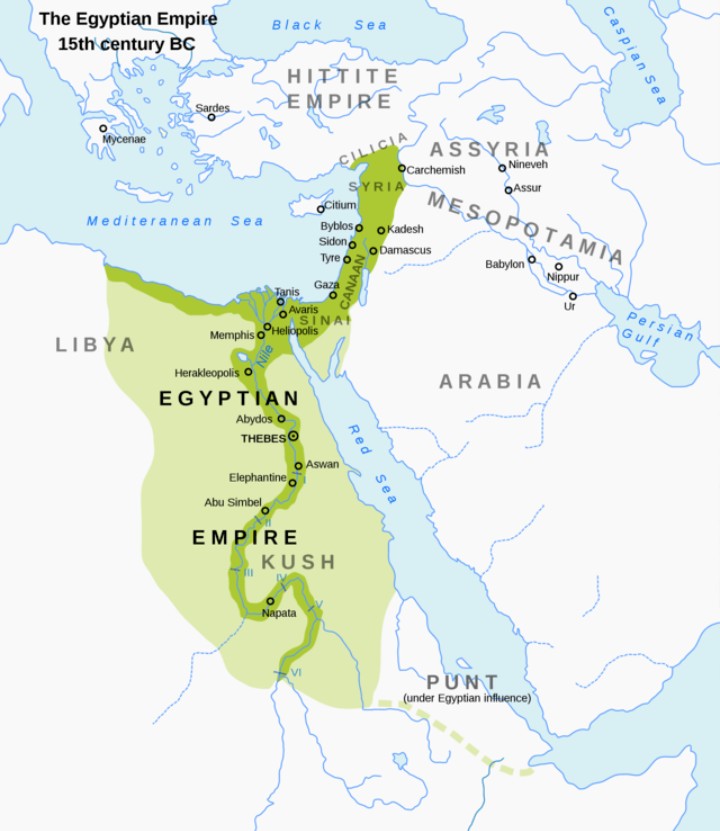The Egyptian Empire rose during the period of the New Kingdom (c. 1570- c. 1069 BCE), when the country reached its height of wealth, international prestige, and military might. The empire stretched from modern-day Syria in the north to modern-day Sudan in the south and from the region of Jordan in the east to Libya in the west. Since the empire rose and fell in the course of the New Kingdom, historians refer to the period as either the New Kingdom or the Egyptian Empire interchangeably.
Egyptian history is divided by later scholars into eras of “kingdoms” and “intermediate periods”; kingdoms were times of a strong central government and a unified nation while intermediate periods were eras of a weak central government and disunity. The New Kingdom emerged from the time known as the Second Intermediate Period (c. 1782- c. 1570 BCE) in which the country was divided between a foreign Semitic people known as the Hyksos holding power in northern Lower Egypt, the Nubians ruling to the south in Upper Egypt, and the city of Thebes in the middle representing the traditional Egyptian government.
The Theban king Ahmose I (c. 1570- c. 1544 BCE) drove the Hyksos out of Egypt and defeated the Nubians, uniting Egypt under his rule from Thebes. In his early campaigns, Ahmose I created buffer states around Egypt’s borders to prevent any other foreign power from gaining a foothold in the country as the Hyksos had. In doing so, he initiated the policy of conquest which would be followed by his successors and give rise to the empire of Egypt.
IN ITS TIME, EGYPT WAS AMONG THE MOST POWERFUL & PRESTIGIOUS EMPIRES OF THE ANCIENT WORLD.
This period is the most famous in Egyptian history. Egypt’s best-known monarchs such as Hatshepsut, Thutmose III, Amenhotep III, Akhenaten, Tutankhamun, Ramesses II (the Great), and Ramesses III all reigned during this time and some of the most famous monuments and temples – such as the Colossi of Memnon and the Temple of Amun at Karnak – were built.
The empire flourished through the reign of Ramesses III (1186-1155 BCE) when invasions (primarily by the Sea Peoples), over-spending which depleted the treasury, corruption of government officials, loss of faith in the traditional role of the king, increased power of the priesthood, and a decline in its international prestige all contributed to its fall. In its time, however, it was among the most powerful and prestigious empires of the ancient world.
The Hyksos in Egypt
The Middle Kingdom (2040-1782 BCE) during the 12th Dynasty is considered Egypt’s “golden age” when cultural and artistic achievements reached their height. During the 13th Dynasty, however, the kings were weaker and more concerned with their own pursuits and court intrigues than the good of the country. During this time, the Hyksos were able to establish themselves at Avaris in Lower Egypt and steadily consolidated their presence until they were able to wield significant political- and military power. The Middle Kingdom fell as the Egyptian central government grew weaker and both the Hyksos in the north and the Nubians in the south grew stronger, initiating the Second Intermediate Period.
Later scribes of the New Kingdom would characterize the time of the Hyksos as an “invasion” and other writers, picking up on this, perpetuated that myth. The Hyksos never invaded Egypt, however; they were initially traders who saw an opportunity to establish themselves in a neglected region of Egypt and took it. Contrary to later reports, the Hyksos were not enemies of Egypt who rampaged through the country burning and looting the temples.
There is ample evidence, rather, that the Hyksos admired Egyptian culture and emulated the Egyptians in many ways. Trade connections between the Hyksos in the north, the Nubians in the south, and Thebes were well-established and the only evidence of the Hyksos destroying temples or sacking cities comes long after their arrival in the land and is thought to have been provoked by individual cities of Lower Egypt or by Thebes. It is also a myth that the Hyksos ruled all of Lower Egypt; their power was limited to just below the Delta region.
Trade went on evenly between the Hyksos, Egyptians, and Nubians until the government at Thebes grew tired of feeling like guests in their own country. The Theban king Seqenenra Taa (also known as T’aO, c. 1580 BCE), interpreted a message from the Hyksos king Apepi – which was probably a request to curtail the Theban practice of hippo hunting – as a challenge to his authority and launched a campaign against the town of Avaris. Ta’O was killed in battle but his cause was taken up by his son Kamose and then by Ahmose I who defeated the Hyksos and unified Egypt.
